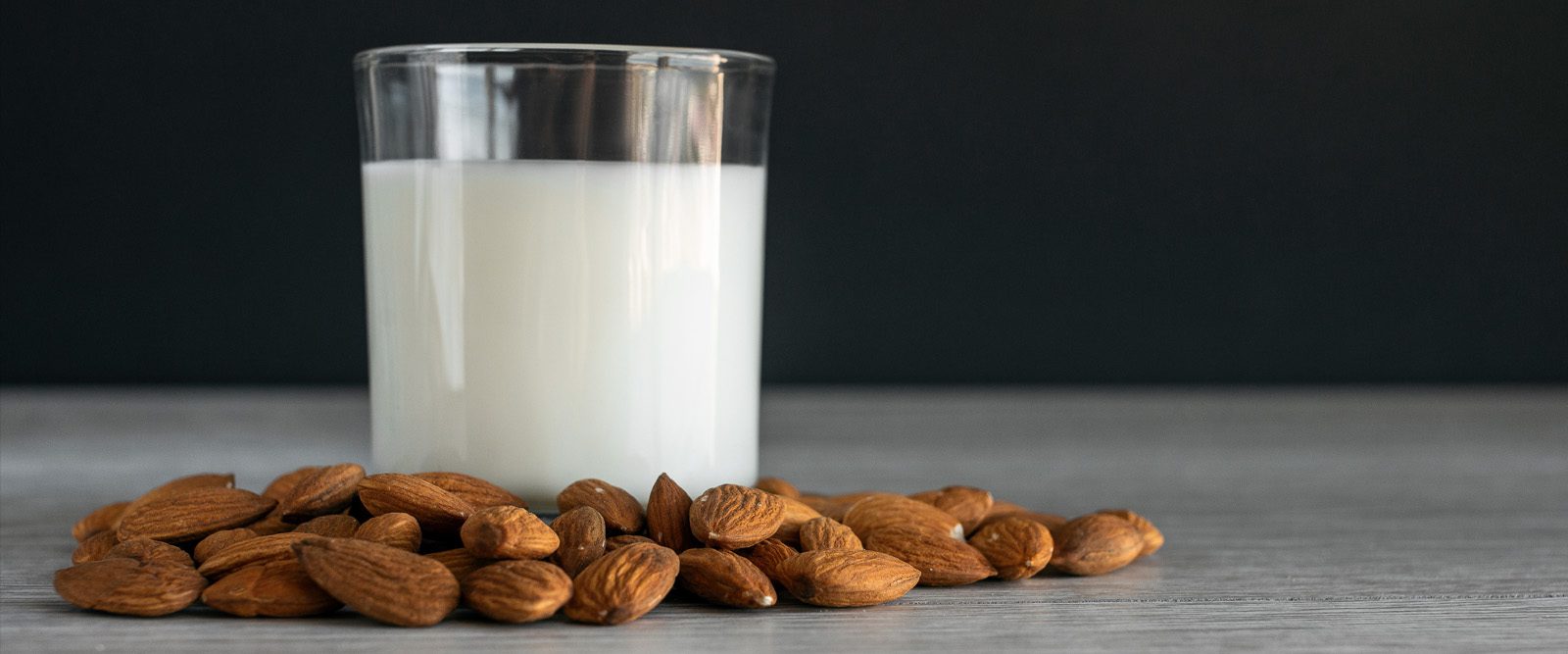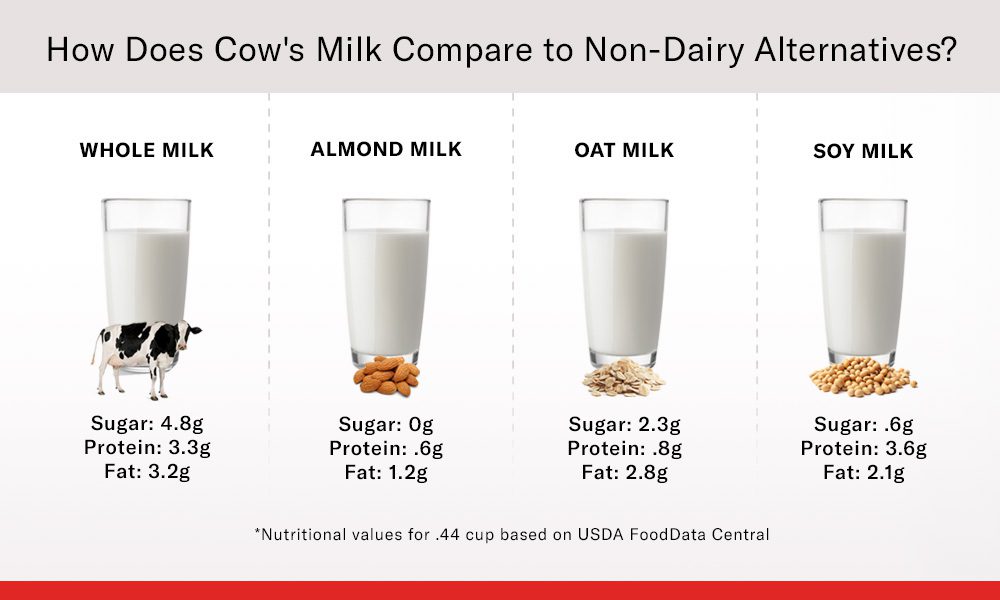What to Know About Non-Dairy Milks
A dietitian breaks down what to look for in non-dairy alternatives, such as soy and oat.

Cow’s milk has long been a refrigerator staple, but today consumers are increasingly filling their cereal bowls and coffee mugs with nut- and plant-based dairy alternatives of the almond, oat, coconut, and soy varieties. According to data from the National Consumer Panel, about 41% of U.S. households bought plant-based milk alternatives in 2022, with a repeat purchase rate of 76%,
People make the dietary change for many reasons — for example if they want to follow a plant-based diet or if they are breastfeeding and their infant has a dairy allergy. To better understand the implications of cutting out cow’s milk, Health Matters talked to Georgia Giannopoulos, a registered dietitian and the manager of NYPBeHealthy, NewYork-Presbyterian’s Health & Wellbeing program, who weighed in on the nutritional benefits of dairy and what you should know if you’re planning to cut it from your diet.
What are the benefits of consuming dairy?
Georgia Giannopoulos: While milk alternatives may be marketed as healthier alternatives to dairy milk, this is not always true depending on what ingredients are added to the milk alternatives and which nutrients may be missing. Cow’s milk is a nutritious option for many people, including children.
Dairy is packed with nutrients, including calcium and protein, and generally fortified with vitamin D, which are important for bone and muscle health among other functions. If individuals limit or avoid dairy, they should take a look at their overall diet and make sure they’re getting enough calcium and protein from other foods.
Does fat content in dairy milk (2%, skim, whole) affect how healthy it is?
There’s no one size fits all when it comes to what type of dairy milk is best. Some prefer skim milk or low-fat 1% milk for the taste or as a way to cut back on fat and calories. Others find 2% milk or whole full-fat milk more satisfying, and fat is linked with satiety and vitamin D absorption, too.
Why might someone want to cut out dairy?
Someone may choose to limit or avoid dairy if they have lactose intolerance, if they follow a vegan lifestyle, for religious beliefs, or taste preferences. If one’s reason for cutting out dairy is to lose weight, a registered dietitian or wellbeing coach may help them navigate this. Many alternative milks have more calories and added sugars than their dairy counterparts, and they may not be fortified with calcium and vitamin D, which are two nutrients we need to keep our bones strong.
How much calcium do we need?
While dietary allowances for calcium vary, an adult between the ages of 19 and 50 years old typically needs about 1,000 milligrams of calcium per day. A cup of yogurt, for example, has about 400 milligrams of calcium.
What are some good non-dairy sources of calcium?
Sardines and other fish canned with the bones are great non-dairy sources of calcium, protein, and also healthy fats. A 3-ounce serving of sardines has almost as much calcium as a cup of yogurt. There are also calcium-fortified products on the market like orange juice and certain cereals. Check the Nutrition Facts label to see how much they have. Dark green vegetables like broccoli, kale, and collard greens have calcium, too.

What’s your take on alternative milks?
Always review the nutrition facts panel, including ingredients, when choosing a milk alternative —whether soy, oat, or almond — as many varieties have added sugars. Healthier options are made with quality ingredients and taste good to you so you will actually drink them. Less healthy alternatives have added sugars and artificial ingredients.
Almonds are a great source of protein, but almond milk is not. A cup of almond milk typically contains about 1 gram of protein, whereas a cup of regular milk has roughly 8 grams and a handful of almonds has about 6 grams. This is fine if someone’s getting enough protein from other sources.
Different non-dairy milks have different amounts of protein, so compare nutrition facts if you’re using these milks as a source of protein.
Many people prefer oat milk with coffee because of its rich texture. If someone needs to avoid dairy and nuts, oat milk may be an attractive option. Like almond milk, 1 cup of unsweetened oat milk has little protein, about 1 gram.
Unsweetened soy milk provides more protein than oat milk and is the most like dairy milk nutritionally, and it’s good for baking since it has a similar amount of protein as dairy milk. Speak with your provider if you have concerns about soy.
While coconut milk beverage is generally low in calories unlike pure coconut milk, which is high in calories, some packaged coconut milk beverages contain additives that may cause digestive discomfort including bloating. If you like the taste of coconut milk beverage, consider making your own by blending unsweetened coconut milk or leche de coco with water to dilute it. This way, you can enjoy the taste with fewer additives and at a lower cost.
What should someone look out for when choosing a milk alternative?
When choosing a milk alternative, check for three things on the nutrition facts label: high in protein, low in added sugars, and made with quality ingredients. Soy milk has a similar amount of protein as cow’s milk, 8 grams per cup serving. Almond milk on the other hand has 1 gram of protein per cup, even though almonds themselves are protein rich.
Review the ingredients of what you’re fueling your body with and try to opt for quality over quantity. Carrageenan is a food additive that manufacturers use to thicken processed foods and beverages such as alternative milks, yogurt, and ice cream. This ingredient is commonly found in processed milk alternatives. While carrageenan is generally recognized as safe, it has been linked with inflammation and digestive distress such as bloating. If food additives like carrageenan bother you, avoid them when possible.
What non-dairy products do you not recommend?
When shopping, review the ingredients on food labels as added sugars may be hidden in many foods, including dairy and non-dairy products. Many flavored almond, soy, and rice milks are loaded with added sugar. In fact, a cup of chocolate soy milk has almost the same amount of sugar as a cup of soda.
Opt for an unflavored option for less sugar. Unsweetened soy milk is a healthy choice that provides a balance of energy and protein.
Ultimately, what’s your stance on the dairy versus non-dairy debate?
It is possible to have a healthful diet whether you eat dairy or not. What’s important is knowing what’s in the food you’re eating and enjoying a variety of foods in moderation.
If you’re concerned about consuming enough calcium and protein, a registered dietitian may help you develop a personalized meal plan that meets your needs. Whether you drink dairy, a milk alternative, or neither, the goal is to regularly fuel your body with the nutrients it needs to thrive.
